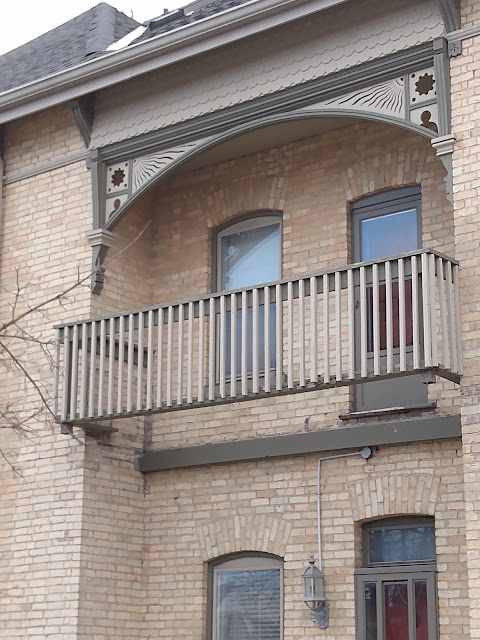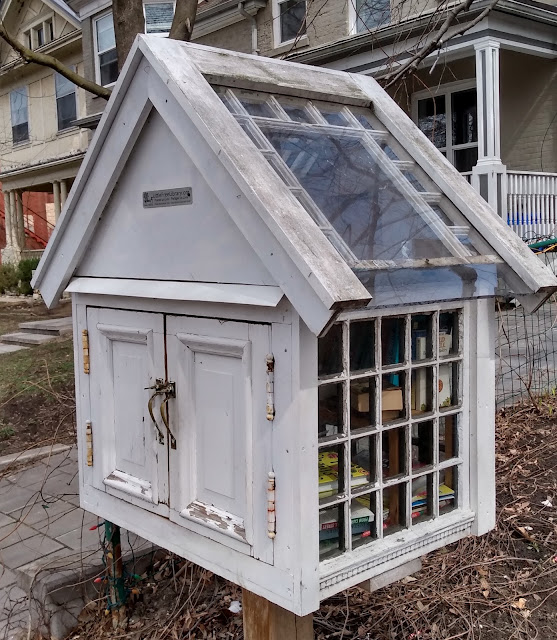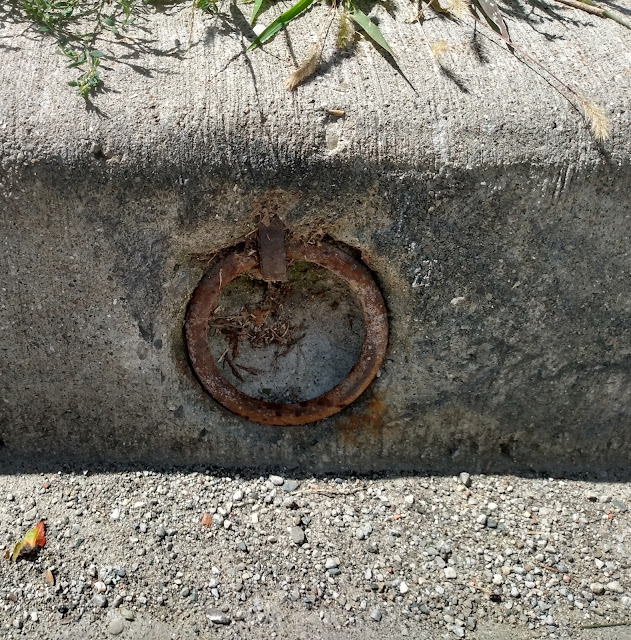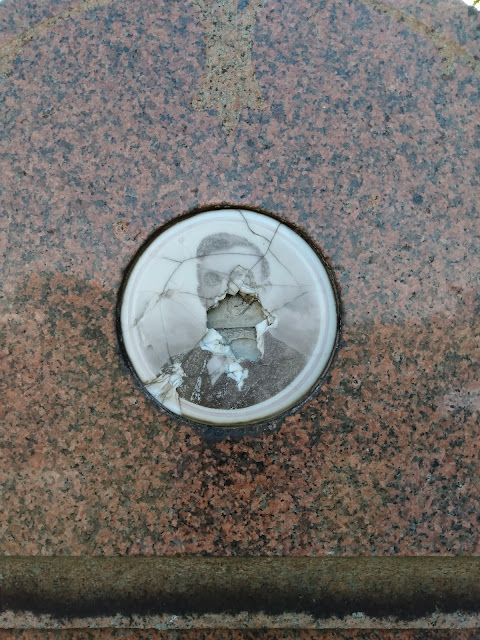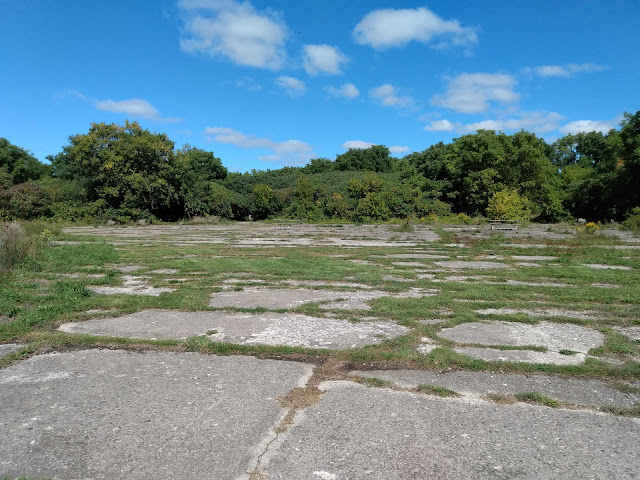Yes, it's that wonderful time of year again, when graveyard geeks like myself take an official bus tour to local cemeteries. I say "official" because some of us indulge in our own personal cemetery tours year-round (except during the depths of winter when the stones are covered in snow). The third annual Middlesex Centre Archives Cemetery Tour, held on October 4, featured three cemeteries, one in each of the historic townships (Delaware, Lobo, and London) that make up today's Middlesex Centre. For highlights from last year's tour, see here.
Creepy, you say? Don't be a cemetery cynic. Burial grounds are interesting indeed!
Our tour started in
Oakland Cemetery, located in the village of Delaware on Millcreek Lane. This cemetery was founded when Christ Church Cemetery, also in Delaware, became full in the 1880s. The church opened what was first known as the "New Cemetery" in the northeast part of the village. Later, it was renamed Oakland, and today, it's operated by the
Diocese of Huron.
I should mention that tour organizers, including our guide, Krista, outdid themselves in providing information about persons buried at each of the sites. At Oakland, archives volunteer Sid Prior placed biographical signs on various graves, just as he did last year when the group visited Christ Church Cemetery. This had the effect of bringing the dead to life - figuratively, anyway - by letting us know who they were and what they did. No longer were they just names on monuments.
An example of Sid's research is below, at the grave of James A. Hughson, M.D., his wife, Fanny, and daughter, Arletta:
A close-up of the sign placed beside the grave describes Dr. H.'s early days on a local farm, his medical education at U. of T., career in Buffalo, meeting Fanny on a house call to her mother, the birth of Arletta in South Dakota, return to Delaware, purchase of an estate in Buffalo, and eventual death at Homewood Sanitarium in Guelph.
A close-up of an interesting advertisement from Buffalo indicates the good doctor could cure many afflictions!
Another bio, for an English emigrant with the distinguished name of Albion Parfitt. ("Albion" is a poetic term for England.)
Mr. Parfitt's career was more local, since he was a merchant in Delaware. His sign is below, decorated with a few morning dewdrops:
The Parfitts were fond of a Latin phrase. I love the sound of Latin myself so I was interested in a nearby monument to Charles Parfitt that reads Beati Mundo Corde ("Blessed are the pure in heart" from the Beatitudes, Matthew 5:8.)
For Charles' wife Caroline, Terar Dum Prosim ("May I be consumed in service.")
Also of interest are monuments to former soldiers, such as William Richard Lowthian (1896-1924), son of Richard V. Lowthian and Edith Brown. William served in the 15th Battalion of the C.E.F. in World War I but died of tuberculosis at Queen Alexandra Sanatorium. His monument reads Pro Patria Mortus est ("He died for freedom and honour"). Perhaps he first became ill in Europe.
Below is a monument to Francis E. Jickels, a member of the Woodmen of the World, whose insignia is on his grave marker. The Woodmen of the World was a fraternal benefit society founded in 1890, which provided insurance and support to its members, including life insurance and a tombstone for those deceased. Note the organization's own Latin motto, Dum Tacet Clamet ("Though silent, he speaks"). Mr. Jickels belonged to Lambeth Camp. No. 102, the word "camp" being reminiscent of a woodmen's lumber camp.
A log or tree stump, sometimes known as a "treestone," usually signifies a life cut short, as in the case of Samuel George Winterbottom, who died in 1912, aged 17. According to a record in ancestry.ca, he died of appendicitis.
A couple of sweet "hearts" mark the graves of Glen and Vera Prior. How romantic!
Members of the Masonic Lodge also have their insignia on their grave markers, as in the example below. I think the bow next to Verna's name means she was a member of the Order of the Eastern Star, an association aligned with Freemasonry.
The earliest grave in the "New Cemetery" is that of Marianne Osborne Girdlestone (1836-88). She was the wife of Charles Fox, who is buried nearby.
Next the tour visited Old Campbell Cemetery on Oxbow Drive near Komoka, in the former Lobo Township. First established in 1837 on the farm of John Campbell, Sr., the cemetery was expanded twice, once in 1919 and again in 1968. And, yes, there is a "new" Campbell Cemetery nearby.
Below is the grave of John Campbell, Sr., who arrived in Lobo in 1825 and died here in 1837. Originally from Inverary, Argyleshire, Scotland, Campbell bought 300 acres of "wild land" just east of Komoka from a man named Secord who lived in London. Campbell's was the first burial here, and, while his stone is eroded, it's still legible:
The monument that most stands out here is this "Guardian Angel" in memory of a mother and daughter. Angels can symbolize so much: spiritual guidance, protection, and grief. The outstretched hand may signify the ascent to heaven, the bowed head sorrow, and the wings flight.
An orb or sphere, such as the one below, may represent eternity, as well as the cyclical nature of life and death:
So aggravating when a grave marker becomes obstructed by nature - in this case, an overgrown tree. This photo is the best I could do for the Rev. Richard Marshall and his wife, Susan. Marshall, a Baptist minister, came from England in 1885; his wife came in 1886. Their grey sandstone altar-type grave should be uncovered by family, a Baptist congregation, or the "Friends of Old Campbell Cemetery," although the latter organization is a product of my imagination.

Stephen Moore, Earl of Mount Cashell, was an unusual member of the aristocracy in that he migrated to the wilds of Upper Canada. Graduating from Trinity College, Cambridge, with an MA in 1812, he later became a Fellow of the Royal Society. While in Switzerland, he met his wife, Anna Marie Wyse. In 1833 they came to Lobo with their large brood of children. Through an agent, the Earl bought a 1,000 acre estate including Thames-front property. They lived in a large house known as the "castle," which would also have housed family servants. The name of the nearby village of Kilworth came from the family title of Lord Kilworth, the eldest son, who was only eight when the family arrived. The monument below is to Jane, wife of the Earl's third son, Hon. George Francis Moore.
The tour stopped for lunch at
Kilworth United Church. No, the church hasn't been converted into a gourmet restaurant; it's still a church. But members of the church did provide tea and coffee while we ate bagged lunches in the church hall. Then they gave us a talk about the church's history.
 |
| View of Kilworth United Church on a greeting card. Photo by Ron Watson. |
Built in 1850, Kilworth is one of the oldest churches - if not buildings - in the area. Founded as an Episcopal Methodist Church, it became part of the United Church in 1925. You may have passed by this structure on Oxford St. W., just west of Byron, many times without noticing it, since it's almost hidden from the road by numerous trees. The building is constructed of stone walls two feet thick. Many are hand-hewn rocks from the nearby Wishing Well spring. Traditionally, those who looked closely would find fossils in the rocks, although erosion has made these more difficult to find.
The building has many updates, especially to its heat and lighting, but its sanctuary is still the plain, simple interior the Methodist settlers would have preferred:
The final cemetery on the tour was Littlewood Cemetery on Twelve Mile Road north of Ilderton in the former London Township. Here, historian Glenn Scarborough gave us an overview of the site's history.
As with many other cemeteries, there was once a church nearby. A Wesleyan Methodist congregation was established in the area in 1847, and a brick church was built nearby on the farm of John Littlewood, who arrived in the area in 1828. This church was replaced in 1875 by a larger brick structure that was eventually moved to Mill Street in Ilderton in 1892, and burned in 1910. Today, the cemetery is in the care of Ilderton United Church.
In the 1940s, a marble triangle with the name of the 1875 church was found in the Scarborough family blacksmith shop. This cairn with a bronze plaque was erected in 1988 to tell the story of the Littlewood churches and cemetery, and the triangle was added to the upper part of the cairn. If you notice that it's not quite a "triangle," that's because, according to Glenn, the piece broke when it was being moved, and the other bottom corner was sliced off to make it symmetrical.
In 1965, a half-acre was purchased to expand this cemetery. It remains open for burials, and some of the graves are quite recent. I, of course, am most interested in the pioneers.
Take John Littlewood, for example. Born in 1775 in Moffat, Scotland, as one of 13 children, he reportedly left home at an early age and ran away to join the navy. And not just any ship either. He apparently served on the HMS Victory under Lord Nelson. What stories he must have had about the old days and the great commander! He didn't share them with his descendants, however, because he never married. Instead, he took an interest in developing the local community, which is no doubt why he donated land for a Wesleyan church and parsonage. (The latter building was eventually moved to Birr.) Littlewood lived to the extraordinary age of 104. According to Glenn, this was because he was a bachelor, a suggestion we ladies pooh-poohed. Littlewood must have been strong to survive such an adventurous, hard life.

The first burial here is that of John Armstrong, also born in the eighteenth century. He and his wife, Rebekah Cotnem (1786-1856), came to Upper Canada from the Lake Champlain district of New York State. This broken monument appears to be for John:
But a newer one has been placed nearby:
In 1930, when Fletcher Charlton died, his heirs decided to donate his estate to the cemetery. The funds allowed a wrought iron fence to be built across the front with the gate posts below:
Two young men who died in World War II are commemorated on their parents' grave markers at Littlewood. Flying Officer John Robert Paisley went missing over the North Sea on May 17, 1942, and was later presumed dead. Born in Ilderton, "Jack" attended London's Central Collegiate and Normal School, and taught school back in Ilderton and up at Thedford before joining up in July 1940. He also played hockey for the Ilderton village hockey team. He is memorialized at Runnymede Memorial, UK.

Also, Sgt. AG John Lewis Sparling (1923-1943), who first attempted to join the Air Force in 1940 but was declined, being underage. He finally enlisted at London in November 1941, just after his 18th birthday. On a night mission on January 21-22, 1943, he left on a mine-laying mission with four other officers. They left from the coast of the Netherlands near the Zuider Zee in a Wellington bomber and never returned. Also remembered at Runnymede. Note that his parents had already suffered a previous disaster in the death of another son, Robert, who drowned while swimming in the Thames.
Most of the information above comes from the day's excellent tour guides and the handouts they gave out. Those looking for further information are recommended to look at ancestry.ca and the following publications:
Gibb, Alice, ed. London Township: A Rich Heritage 1796-1997. London Township History Book Committee, 2001.
Grainger, Jennifer, ed. Delaware and Westminster Townships: Honouring Our Roots. Delaware/ Westminster History Book Committee, 2006.
The Heritage of Lobo 1820-1990. Lobo Township Heritage Group, 1990.































